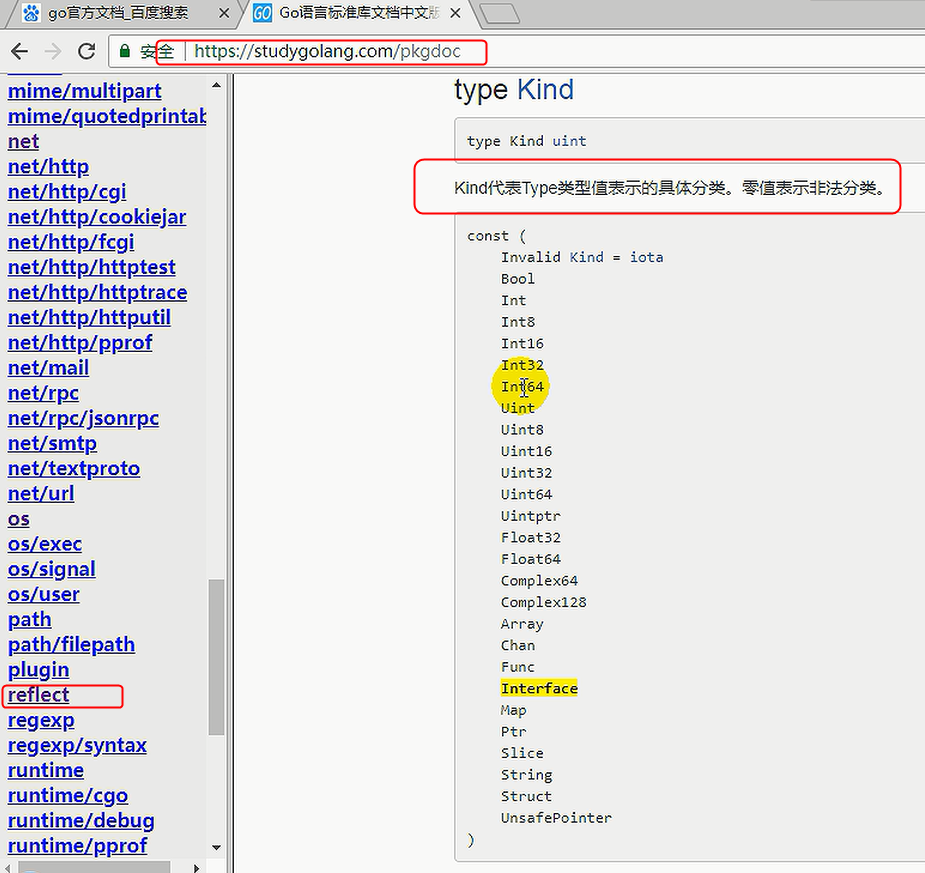go 反射的快速入门
此处的变量reflect.TypeOf, reflect.ValueOf, 返回的 其实表示的不是真正的int,它是 reflect.TypeOf(b) 返回的type Type interface, 接口,里面包含了很多方法 不能 var a int = 10, var a1 rType=20
package main
import (
"fmt"
"reflect"
)
//专门演示反射
func reflectTest01(b interface{}) {
fmt.Printf("06>> iv = %v, type=%T\n",b,b) // 无法用%T查看出接口类型
num3 := b.(int)
fmt.Printf("07>> num2=%v type=%T\n",num3, num3)
//通过反射获取的传入的变量的type , kind,值
//1。先获取到 reflect.Type
// 此处的变量rType 其实表示的不是真正的int,它是 reflect.TypeOf(b) 返回的type Type interface, 接口,里面包含了很多方法 不能 var a int = 10, var a1 rType=20
rTyp := reflect.TypeOf(b)
fmt.Printf("01>> rType=%v type=%T \n", rTyp,rTyp)
//2.获取到 reflect.value
rVal := reflect.ValueOf(b)
//n1 := 2 + rVal 此处不能编译,说明rVal也不是真正的int'类型100
fmt.Printf("02>> rVal=%v rVal type=%T\n", rVal,rVal)
// 求出真正的int
n2 := 2 + rVal.Int() //
fmt.Printf("03>> n2=%v n2 type=%T\n", n2,n2)
//n3 := rVal.Float() // 如果取的类型不对, 会报错 panic: reflect: call of reflect.Value.Float on int Value
//fmt.Println("n3=", n3)
//下面我们将 rVal转成interface{}
iV := rVal.Interface()
fmt.Printf("04>> iv = %v, type=%T\n",iV,iV)
//将interface{}通过断言转成需要的类型
num2 := iV.(int)
fmt.Printf("05>> num2=%v type=%T\n",num2, num2)
}
//专门演示反射
func reflectTest02(b interface{}) {
//通过反射获取的传入的变量的type , kind,值
//1。先获取到 reflect.Type
rTyp := reflect.TypeOf(b)
fmt.Printf("08>> rType=%v type=%T \n", rTyp,rTyp)
//2.获取到 reflect.value
rVal := reflect.ValueOf(b)
//3.获取变量对应的Kind
//(1)rval.Kind()==>
kind1 := rVal.Kind()
//(2) rTyp.Kind()==>
kind2 := rTyp.Kind()
fmt.Printf("09>> kind1 =%v kind2=%v \n", kind1, kind2)
//下面我们将 rVal转成interface{}
iV := rVal.Interface()
fmt.Printf("10>> iv = %v, type=%T\n",iV,iV)
//将interface{}通过断言转成需要的类型
//这里,我们就简单使用了一带检测的类型断言。
//同学们可以使用switch 的断言形式来做的更加的灵活
stu,ok := iV.(Student)
if ok {
fmt.Printf("11>> stu.Name=%v \n", stu.Name)
}
}
type Student struct {
Name string
Age int
}
func main() {
//请编写一个案例,
//演示对(基本数据类型、interface{(}、reflect. value)进行反射的基本操作
//1。先定义一个int
var num int = 100
reflectTest01(num)
//2.定义一个student的实例
stu := Student{
Name : "tom",
Age : 20,
}
reflectTest02(stu)
}
输出:
06>> iv = 100, type=int
07>> num2=100 type=int
01>> rType=int type=*reflect.rtype
02>> rVal=100 rVal type=reflect.Value
03>> n2=102 n2 type=int64
04>> iv = 100, type=int
05>> num2=100 type=int
08>> rType=main.Student type=*reflect.rtype
09>> kind1 =struct kind2=struct
10>> iv = {tom 20}, type=main.Student
11>> stu.Name=tom

通过反射指针修改值 Elem的使用
package main
import (
"fmt"
"reflect"
)
func reflect01(b interface{}) {
//2。获取到 reflect.value
rVal := reflect.ValueOf(b)
//看看rval的Kind是
fmt.Printf("rva1 kind=%v \n", rVal.Kind())
//3.rVal
// Elem返回v持有的接口保管的值的value封装,或者v持有的指针指向的值的value封装
rVal.Elem().SetInt(20)
}
func main() {
var num int = 10
reflect01(&num)
fmt.Println("num=", num) // 20
/*
你可以这样理解rval.Elem()
num := 9
ptr *int = &num
num2 := *ptr //===类似 rva1.Elem()
*/
}
输出:
rva1 kind=ptr
num= 20
2测试
package main
import (
"fmt"
"reflect"
)
func main() {
type S struct {
F string `species:"gopher" color:"blue"`
}
s := S{}
fmt.Printf("001 类型=%T,字符=%s,详细类型=%#v \n",s,s,s)
st := reflect.TypeOf(s)
fmt.Printf("002 类型=%T,字符=%s,详细类型=%#v \n",st,st,st)
field := st.Field(0)
fmt.Println(field.Tag.Get("color"), field.Tag.Get("species"))
}
输出:
001 类型=main.S,字符={},详细类型=main.S{F:""}
002 类型=*reflect.rtype,字符=main.S,详细类型=&reflect.rtype{size:0x10, ptrdata:0x8, hash:0xcdb468b2, tflag:0x7, align:0x8, fieldAlign:0x8, kind:0x19, equal:(func(unsafe.Pointer, unsafe.Pointer) bool)(0x403500), gcdata:(*uint8)(0
x4eaa60), str:4470, ptrToThis:28448}
blue goph
写入自己的博客中才能记得长久



【推荐】国内首个AI IDE,深度理解中文开发场景,立即下载体验Trae
【推荐】编程新体验,更懂你的AI,立即体验豆包MarsCode编程助手
【推荐】抖音旗下AI助手豆包,你的智能百科全书,全免费不限次数
【推荐】轻量又高性能的 SSH 工具 IShell:AI 加持,快人一步
· 被坑几百块钱后,我竟然真的恢复了删除的微信聊天记录!
· 没有Manus邀请码?试试免邀请码的MGX或者开源的OpenManus吧
· 【自荐】一款简洁、开源的在线白板工具 Drawnix
· 园子的第一款AI主题卫衣上架——"HELLO! HOW CAN I ASSIST YOU TODAY
· Docker 太简单,K8s 太复杂?w7panel 让容器管理更轻松!